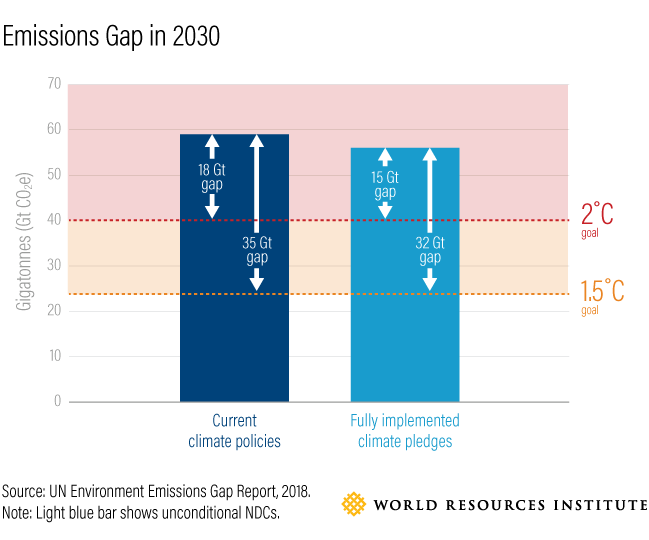This year we learned, once again, that climate change is not a distant phenomenon—it is here right now. Extreme weather hit communities around the globe, ice and glaciers shrunk and global greenhouse gas emissions grew. Many of these events are in line with projections of a warming world. At the same time, our understanding of climate science greatly improved, allowing us to better understand past impacts and what the future holds.
Here are some highlights from 2018:
Extreme Weather and Climate Events
Extreme Heat
In June, Oman saw its highest minimum temperature at 108.7°F, a new Asian record. A new record was likely also set for the hottest temperature in Africa, at 124°F in Ouargla, Algeria.
Meanwhile, Japan’s summer heat wave resulted in 22,000 people hospitalized with heat stroke. Temperatures rose above 110°F in Southern California in early July; electricity demand for air conditioning was so high that the lights went out for tens of thousands.
Fires Blaze Around the World
California saw its deadliest and most destructive wildfire in history, killing 85 people. The fires forced Yosemite National Park to close at the peak of visitor season. Greece witnessed extensive fires that killed 85 people and injured another 180. Australia has recently experienced devastating bushfires, coupled with scorching heat waves.
Surprisingly, fires also hit regions that are typically wetter and cooler, such as England’s peatland moors and Ireland. They swept above the Arctic Circle in Sweden, which faced unprecedented drought. More than 50 wildfires burned, causing officials to reach out for foreign assistance.
Changing Precipitation Patterns
In July, Japan experienced record-high rainfall and extensive flooding and mudslides, with thousands of houses damaged and at least 122 lives lost; the government instructed 5 million people to evacuate. In India, drought and resultant crop failures in India’s Madhya Pradesh state led to significant migration; the region has seen roughly half of its usual rainfall in the last few years. And in August, Kerala, India experienced heavy rainfall and one of the worst floods on record, leading to hundreds of deaths.
Intense Storms
Hurricane Florence and Hurricane Michael, which swept across the Carolinas and Florida, respectively, were two of the most destructive storms in U.S. history. Typhoon Mangkhut ravaged the Philippines and Hong Kong.
Shrinking Ice
Arctic sea ice extent this past January and February was the smallest for those months since record-keeping began in 1979. An 11-million-ton iceberg originating from a glacial outlet in Eastern Baffin Bay became lodged off a small village in Greenland, forcing evacuations in case it overturned.
Record Carbon Dioxide Emissions
The Global Carbon Project projected that carbon dioxide emissions will climb to a record 37.1 gigatonnes in 2018. Carbon dioxide emissions from fossil fuel sources grew by 2.7 percent over the past year, after a 1.6 percent increase in 2017. Emissions growth in 2017 and 2018 followed a three-year plateau.
While the picture for 2019 is still uncertain, the Global Carbon Project expects even further emissions growth in 2019 given a persistent increase in oil and natural gas consumption and projected economic growth. This is deeply troubling considering that the latest climate science suggests that global emissions should peak by 2020 to have a good chance of avoiding some of the worst climate impacts.
Major Climate Studies in 2018
The science of attribution, which attempts to determine whether a particular extreme event is driven by climate change or is within the bounds of normal, is improving. Scientists are also providing faster analysis to help connect the dots between climate change and extreme weather events. The past year saw the release of several groundbreaking reports:
U.S. National Climate Assessment
The Fourth National Climate Assessment Report provided a clear message that climate change is already affecting every sector and region in the United States. Further warming will wreak havoc on the nation’s health, lands and economy. Scientists found that warming above 2°C (3.6°F) would kill 10,000 Americans annually and cause tens to hundreds of billions of dollars in economic damage. The world has already warmed by 1°C.
UN Emissions Gap Report
The UN’s annual Emissions Gap Report found that there is a large and growing gap between where emissions are headed and where they need to be to prevent the worst impacts of climate change. The report also revealed that only seven G20 countries (Australia, Brazil, China, EU, India, Japan and Russia) are currently on track to achieve the emissions-reductions pledges they made as part of the international Paris Agreement on climate change.

IPCC Special Report on 1.5˚C
While it’s still technically feasible to avoid a 1.5˚C rise in temperature, the Intergovernmental Panel on Climate Change (IPCC) Special Report on 1.5˚C found that behavior and technologies will need to shift dramatically in order to achieve the necessary emissions reductions. While there have been examples of rapid change in specific technologies or sectors in the past, there is no precedent in our documented history for the rate of change at the scale required for limiting warming to 1.5˚C.

The report also found that limiting temperature rise to 1.5°C versus 2°C makes a huge difference in terms of the resulting risks and impacts communities will face.

Learning from 2018
We now know more about climate change than we ever have before. Communities around the world experienced the effects of a warmer world in 2018, while researchers painted a very clear and alarming picture of how much worse things will get unless we change course.
May 2019 be the year we put these learnings into action and start rapidly reducing greenhouse gas emissions.



